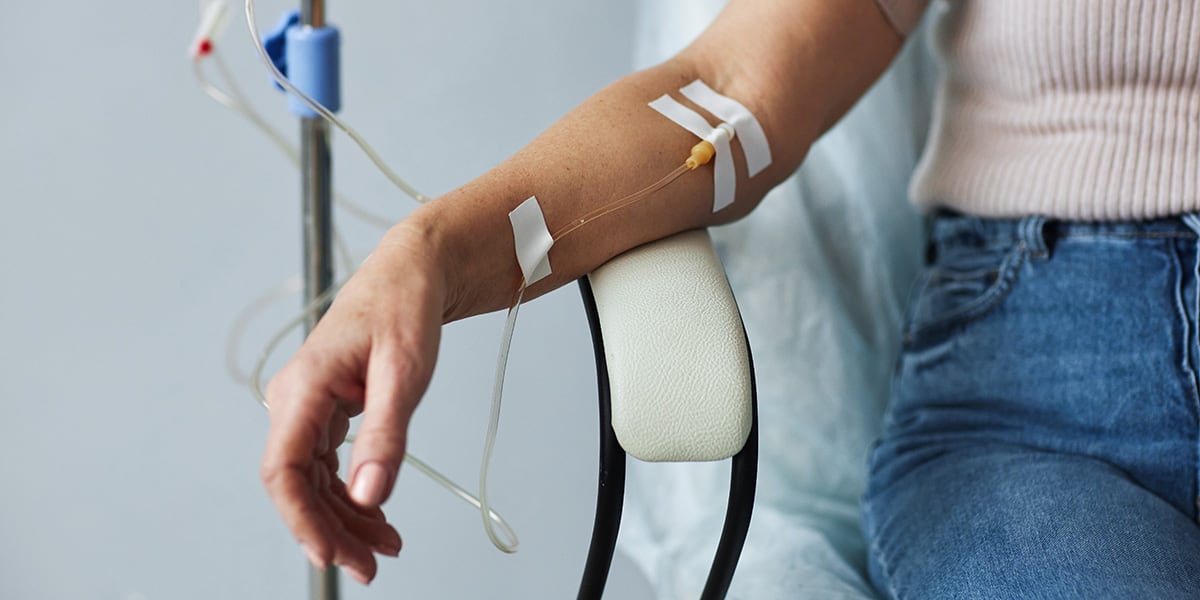
While most people have some understanding of what’s involved in breast cancer treatment, if you’ve just gotten a breast cancer diagnosis, you might not be fully sure what’s ahead. Your treatment path will depend on your specific diagnosis as breast cancer treatments are adjusted to each patient’s individual case.
As well as medical treatments, there are many non-medical methods and therapies that can make it easier to cope with breast cancer, whatever stage you’re at. Let’s run through a quick overview of the key medical and non-medical therapies so you can better understand your options.
In this article, you’ll learn about:
- Treatment options like surgery, medication, and radiation
- Factors healthcare providers take into account when deciding on treatments
- Benefits of non-medical therapies and self-care activities
What are the Treatments for Breast Cancer?
Breast cancer treatments encompass a variety of approaches, each tailored to the patient’s specific type and stage of cancer. The primary breast cancer treatment options are surgery, radiation therapy, and chemotherapy, each playing a crucial role in managing the disease.
Surgery often involves removing the tumor and sometimes the surrounding breast tissue, depending on the cancer’s extent. Radiation therapy and chemotherapy are used to treat breast cancer by targeting and destroying cancer cells, either throughout the body or in specific areas. Additionally, hormone therapy and targeted therapy are also key treatment options for breast cancer, and are particularly effective in certain types of tumors.
It’s important to note that after breast cancer surgery, side effects can vary depending on the treatment type and extent. Managing these side effects is a significant aspect of the overall treatment plan. These treatments may be used individually or in combination, depending on the individual case, to effectively manage and treat breast cancer.
What Determines Which Treatment Option is the Right One?
Determining the right treatment option for breast cancer is a crucial step following diagnosis. The medical team will present all available treatment choices, carefully considering several factors to tailor the approach to the specific needs of the patient.
These factors include:
- the size and type of the tumor
- its growth rate
- and whether it has metastasized to other organs.
Ultimately, the decision rests with the patient, as patient involvement is key in the treatment process. Believing in the efficacy of the chosen treatment can significantly impact how a patient copes with it: A thorough understanding of the treatment can alleviate concerns and fears, empowering patients to make informed decisions about their health journey. This approach ensures that the treatment for breast cancer aligns with both medical recommendations and personal preferences, contributing to a more effective and reassuring treatment experience.
Which Breast Cancer Therapies are Often Combined?
In the treatment of breast cancer, specialists often combine various therapies to enhance effectiveness and improve the chances of a cure or remission. One common approach is to use breast cancer surgery as the primary medical procedure, which may involve removing the tumor or, in some cases, the entire breast. This surgery for breast cancer is frequently preceded by or followed by additional treatments to reduce the risk of recurrence.
Pre or post-surgery, breast cancer medication, often in the form of chemotherapy or hormone therapy, is typically administered. These breast cancer drugs are designed to target any remaining cancer cells, preventing them from growing or spreading. Radiation therapy is another adjunct treatment, especially useful after surgery to eliminate residual cancer cells in the breast or surrounding areas.
While no single approach guarantees a cure for breast cancer, this combination of surgery, medication, and sometimes radiation, offers a comprehensive strategy to combat the disease. Breast cancer specialists tailor these treatments based on individual patient factors, such as the cancer’s stage and type, as well as the patient’s overall health, to enhance the potential for a successful outcome.
What are Some Surgical Approaches in Breast Cancer Treatment?
Breast cancer surgery has evolved significantly, offering more options beyond the traditional removal of the entire breast. A key approach is breast-conserving surgery, where the goal is to remove the tumor while preserving as much of the healthy breast tissue as possible. This technique does not necessitate the removal of the entire breast, often resulting in a post-operative appearance that closely resembles a normal breast. However, if there are noticeable changes in the breast’s shape, reconstructive techniques using tissue from other body parts or synthetic materials can be employed to restore the breast’s appearance.
The possibility of breast cancer spreading through the lymphatic system also influences surgical decisions. If cancer has spread to lymph nodes, often located in the underarm region, these lymph nodes may also be removed during the procedure.
In certain situations, the complete removal of the breast, known as a mastectomy or ablation, becomes necessary. This extensive procedure, often including the removal of the nipple, is typically considered when breast-conserving surgery is not possible due to factors like the tumor’s size or spread, or if the tumor cannot be fully excised through conservative means.
A mastectomy might also be chosen if post-operative radiation is not feasible or as a personal decision based on cosmetic considerations and the patient’s preference for either radiation therapy or a more extensive surgical approach.
Each surgical option is carefully considered by breast cancer specialists, balancing the need for effective cancer removal with the patient’s personal and medical circumstances.
How Does Radiation Therapy Work in Breast Cancer Treatment?
Following surgery, radiation therapy often comes into play as a crucial next step. This therapy is recommended in certain cases to significantly lower the risk of cancer recurrence. The primary aim of radiation therapy is to target and destroy any cancer cells that might remain after surgery. Typically, these sessions are brief, lasting only a few minutes, and are painless. The treatment schedule usually spans several weeks, with therapy administered multiple days a week.
Side Effects of Radiation Therapy
Although radiation therapy is a pivotal part of breast cancer treatment, it’s important to be aware of potential side effects. Initial sessions might lead to:
- skin changes such as itching or swelling
- Other skin changes resembling sunburn effects such as irritation, redness, blistering and peeling.
Other common side effects include:
- Fatigue
- localized pain
- and possible issues with lymph nodes or lungs.
There’s also a heightened risk of secondary tumors. For a more comprehensive understanding of radiation therapy, including its long-term effects and management strategies, refer to our detailed article dedicated to radiation therapy for breast cancer.
Finding the Right Drug Therapy for Breast Cancer
Besides surgery and radiation, drug therapy plays a crucial role in breast cancer treatment. Recent advancements have significantly improved this aspect of care. The choice of drug therapy is based on the tumor type and the extent of disease spread.
What is Chemotherapy and How Does it Work?
Chemotherapy utilizes cytostatic or cytotoxic drugs, administered typically through an intravenous drip, to target cancer cells throughout the body. These drugs are designed to halt the division of cancer cells, effectively destroying them throughout the body..
Chemotherapy Side Effects
Since chemotherapy tends to affect rapidly dividing cells, it can also impact healthy cells in areas with rapidly dividing cells such as the hair roots, the mouth lining, gut, and the bone marrow. Common side effects include:
- hair loss
- mucous membrane issues
- Nausea
- Vomiting
- Anemia
- and increased infection risk.
For more information, please refer to our article about chemotherapy for breast cancer patients.
How Does Hormone Therapy Combat Breast Cancer?
Hormone therapy, is utilized for tumors that are estrogen and/or progesterone receptor-positive or dependent. It involves drugs that inhibit the body’s production of estrogen or stop the effects of estrogen on the cancer, helping to prevent or delay the disease’s progression or recurrence.
Hormone Therapy Side Effects
As hormone therapy impacts the entire body, it can induce menopause-like symptoms, such as:
- hot flashes
- weight gain
- sleep disturbances
- and joint or muscle pain.
What Role Do Antibodies Play in Treating Breast Cancer?
Antibody therapy involves laboratory-made antibodies that are infused into the veins. These antibodies are designed to identify and eliminate diseased or mutated cells. This therapy is contingent on the tumor having specific surface structures, which are determined through tissue examination.
Side Effects of Antibody Therapy
While antibody therapy can cause flu-like symptoms, such as fever and muscle pain, it is generally not too difficult to manage. Unlike chemotherapy, it more specifically targets the tumor, sparing most healthy cells. There can be severe side effects, such as bleeding or heart and lung problems, but these are generally rare.
What Are Signaling Pathway Inhibitors and Their Role?
Signaling pathway inhibitors, a newer class of cancer drugs, target specific processes within cancer cells that drive tumor growth. These drugs are effective only if the cancer cells possess certain characteristics.
Potential Side Effects of Signaling Pathway Inhibitors
Despite their targeted approach, these drugs can still affect healthy tissue, leading to side effects like skin reactions, redness and blistering on hands and feet, high blood pressure, and diarrhea.
What are Non-Medical Approaches to Breast Cancer Care?
Non-medical and non-surgical treatments for breast cancer often focus on complementary and supportive care to enhance quality of life and manage symptoms. These treatments are typically used alongside conventional medical treatments rather than as replacements.
Breast cancer patients have a range of these options. Some of them may be recommended from the treatment team while others are up to the patient’s choice to test them out.
Physical Therapy and Rehabilitation
This can be useful to help restore strength, improve physical functioning, and manage side effects like lymphedema.
Nutrition and Dietary Support
Focusing on a balanced diet to maintain strength and energy levels, and potentially improve treatment outcomes.
Psychological Support and Counseling
Including therapy and support groups to help cope with the emotional and mental stress of a breast cancer diagnosis and treatment.
Exercise and Fitness Programs
Tailored exercises can help maintain strength, reduce fatigue, and improve mood.
Mind-Body Techniques
Such as meditation, yoga, and relaxation techniques to reduce stress, anxiety, and improve overall well-being.
Acupuncture and Acupressure
Often used to alleviate pain, nausea, and fatigue associated with cancer treatments.
Massage Therapy
To reduce stress, alleviate pain, and improve circulation.
Herbal Supplements and Natural Remedies
While these should be used cautiously and under the guidance of a healthcare professional, some people find them helpful for managing symptoms.
Art and Music Therapy
Creative therapies can provide emotional relief, reduce stress, and offer a means of expression and coping.
Aromatherapy
Using essential oils for relaxation and stress reduction.
In summary
The landscape of breast cancer treatment has evolved considerably, now offering a diverse range of personalized therapies tailored to each individual’s unique situation. Typically, a combination of treatments, such as surgery, radiation therapy, and various drug therapies including chemotherapy, hormone therapy, and targeted therapy, are employed.
However, it’s important to note that not all treatments are necessary or applicable for every patient, as each treatment plan is carefully customized to the specific needs and circumstances of the individual.
Complementary and supportive care can enhance the quality of life and coping with the disease.
FAQ
References
Uta Leyke-Hess holds a degree in business administration with a strong focus on healthcare. Since 2015, she has been supporting various medical websites by creating high-quality, yet easy-to-understand content with the help of a team of qualified external writers she has assembled.
Since her additional qualification as a Medical Writer from the Apollon University of Applied Sciences in Health Economics, she has been writing medical texts, which are then proofread by doctors.

